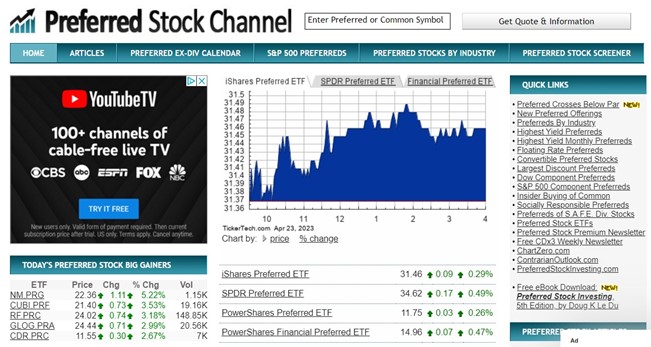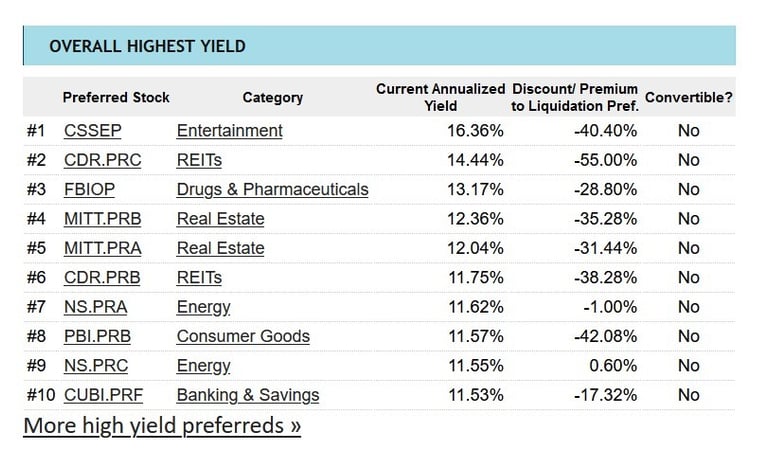What I Love About the Preferred Stock Channel
Many websites offer Investment advice. Without hesitation, I can say that the Preferred Stock Channel has been one of the best in consistently guiding me to stocks that have made good money on dividends. There are 3 categories of investments that mainstream magazines and writers tend to overlook. Many of the huge hedge funds include these 3 types of investments in them. Those 3 slightly mentioned investments are BDC (Business Development Companies), CEFs (Closed End Funds), and Preferred Stocks.
David Parham
7/23/20245 min read


DISCLAIMER - I am not a Financial Advisor and do not work for any Brokerage Firm. The opinions given are my own and are not to be used as professional advice. These are my findings and can hopefully help you to make informed decisions on investing. Consult a Broker or Lawyer before making any investment.
WHAT I LOVE ABOUT THE PREFERRED STOCK CHANNEL
There are so many websites offering stock market advice today. It is difficult to know which ones to use and which to ignore. I looked at dozens of them in the last year. Without hesitation, I can say that the Preferred Stock Channel has been one of the best in consistently guiding me to stocks that have made good money on dividends. There are 3 categories of investments that mainstream magazines and writers tend to overlook. Many of the huge hedge funds include these 3 types of investments in them. Those 3 slightly mentioned investments are BDC (Business Development Companies), CEFs (Closed End Funds), and Preferred Stocks.
I won’t discuss a lot about these, but I can say these 3 plus my Dividend Growth Stocks have been responsible for over 80% of my returns in the last few years. Read about each of those here:
Business Development Companies - BDCs
Many Preferred Stock shares pay excellent dividends, and some pay above 10%. Many can be purchased well below their par value which is normally $25 per share.
Preferred Stocks (or Preferred Shares) are simply a class of equity stocks. They hold a senior position over common shares. One of the big differences (which is of little significance to small investors) is that Preferred Shares do not hold voting rights.
In concept, they are much like a bond, but they are not a debt. In case of bankruptcy, bonds being debt would be paid first, then Preferred Shares, and if any money was left, the rest would be paid to the common stock shareholders.
Preferred Stocks typically always sell at $25 which is par value. If you pay over $25 a share, you are paying a premium. Under $25 means you are purchasing at a discount. The dividends are paid on the value of $25 even if you purchased it at a lower rate, meaning you can get substantially higher returns than the stated rate if you buy at a good discount.
It is easy to understand that if you can buy something below it’s Net Asset Value, then money can potentially be made if the stock moves back to its par value. I have purchased many of these over the past year paying 12 to 19% dividends.
As I mentioned last week, every time I buy an investment, on that day, I issue a stop loss order to sell it if it drops to 92% of the price I paid. Each month if it increases in value, I set it to the new higher 92% value. Over 90% of the ones I purchased are still active after holding them for months. Of the few that did sell off, some happened after 6 months and quarterly dividends were paid once or twice.
Bottom line is they are very profitable when doing it with my stop loss immediate sale if price drops. If some unforeseen news comes out on a company, I don’t have to be concerned about that and I just let the stop loss order handle the dip. Of course sometimes there is a momentary 10% drop and you would have made more if you had rode out the dip.
However, what I am concerned about is the 40% drops where you can rarely make up for the loss over 2 to 3 years. Nothing prevents us from coming back after the stock price settles and repurchasing the same stock again.
So what is so great about the Preferred Stock Channel (PreferredStockChannel.com)? They show you what is paying the highest dividends. Remember: Always always always, look up the company and see why the stock is paying such a high dividend. Sometimes a company is in distress, and you may wind up losing money on that kind.
However, if you pay attention to these, some are just out of favor in the stock market or have gone through a dip in price. I pay attention to the charts and don’t buy if on a steady downhill slide. Look for a bottom on the chart and at least some rebound. Also look at the 52 week price range. If near the top of the 52 week price range, I do not buy. I always review all the tabs at Fidelity.com on all stocks and ETFs before I buy and see the analysts opinions.
You need to be sure that the stock is Cumulative, Perpetual, Redeemable, and preferably Fixed Dividend. (Meaning Non-adjustable interest.) I always buy at a discount, never at a premium. In other words, the prices is ALWAYS under $25 or I move to the next one. These are some of the things the Preferred Stock Channels helps me to identify. They send out a weekly email that is super (be sure to sign up for that. I read them all every week. Here is an example from an old article:


I used this chart to look at several of these, and found no apparent reason to fear CSSEP. Chicken Soup for the Soul Preferred Stock. Here is the information from Fidelity when I researched CSSEP. The highlighted items are important. Price is well below the Par value of $25 (40% discount) and paying 16.357% dividend on April 27. Note major dip and recovery in the graph. I bought this stock back when article appeared.
There are so many options on the Preferred Stock Channel that I could not possibly cover all the options. However, here is one of my favorite links that shows the average by industry how the stocks are paying. Then you can click on the ones you are interested in and look at the list making up that industry.
This weekly Preferred Stock Channel email is worthy of study.
As always, I want to encourage you to do your own studies and make no decisions on buying or selling without consulting an investment advisor or an attorney. These are just for examples of how I use the Preferred Stock Channel to help me make decisions.
Keep studying investments. There is a dividends group on Facebook that allows members to offer up advice on good paying dividend stocks and ETFs. I am member of that group and have found some good (and some not so good) advice there. Study and study some more. Have a great week finding some good dividend stocks to purchase.
Contact
davidparham@lifecanbesimple.net
Follow
Connect with Us
+1 940-730-5105